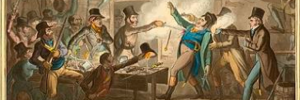Jane Griffin: A Mysterious Figure in London’s History
Some stories from London’s history capture the imagination, while others fade away. The tragic tale of Jane Griffin, however, is one that should not be overlooked. Although not a well-known figure, Griffin’s story offers a compelling lesson about the consequences of unchecked anger.
Who Was Jane Griffin?
A central figure in London during her time, Jane Griffin was a successful tavern owner, operating the popular Three Pigeons along with her husband. Nestled in Butcher Hall Row, the tavern was a favourite gathering spot for booksellers. Its location, near what is now known as Paternoster Square, puts it right in the heart of today’s bustling city. Despite her business acumen, Griffin was notorious for her volatile temper – a trait that would lead to dire consequences.
The Rising Tensions between Jane Griffin and Elizabeth Osborn
Working under Griffin’s employment was a maid named Elizabeth Osborn. Osborn’s job brought her in the direct line of Griffin’s fiery temper. Griffin’s uncontrollable anger led to a violent incident where she injured Osborn’s arm during a dispute. Fearing for her safety, Osborn confided in a surgeon, expressing her fears that Griffin might take her life. Griffin’s husband attempted to mediate, but Griffin’s dismissive response made it clear she held little regard for Osborn’s wellbeing.
The friction between Griffin and Osborn came to a tragic climax on December 1st. An argument over a missing key turned deadly. On that fateful night, Griffin’s husband was entertaining two guests, Mr Tannet and Mr Lund. Interrupted by a summons to the kitchen, he found Osborn lying on the floor, bleeding profusely from a chest wound. When asked who had inflicted the injury, Osborn gasped “Mistress,” implicating Griffin as her assailant before drawing her last breath.
Jane Griffin’s Arrest, Trial, and Sentence
Despite Griffin’s claim that Osborn’s death was an unfortunate accident, the authorities were not convinced. Griffin was promptly arrested and imprisoned at Newgate Prison. Initially, she believed she would be absolved, but Osborn’s dying accusation – “Mistress” – turned the tide against her at trial. The jury found her guilty and Griffin was condemned to death. Despite her sentence, she never admitted to the crime.
As she faced her impending execution, Griffin’s thoughts turned to her daughter. She left behind a heart-rending warning, emphasizing the dangers of an uncontrolled temper. Urging her child to learn from her mistakes, Griffin’s poignant message acts as a timeless reminder of the potential devastation caused by unchecked anger.
Jane Griffin’s tale provides a stern warning about the extreme consequences of unchecked anger. While she may not be a prominent figure in the annals of London’s history, Griffin’s story – and the lessons it offers – remains relevant to this day. As we delve into her tale, we’re reminded of the potential repercussions of our actions, making Jane Griffin’s story a fascinating, if cautionary, part of London’s history.
Find out more stories of London crime in our Heretics and Horrors Walk.
Private Heretics and Horrors Tour also available.




